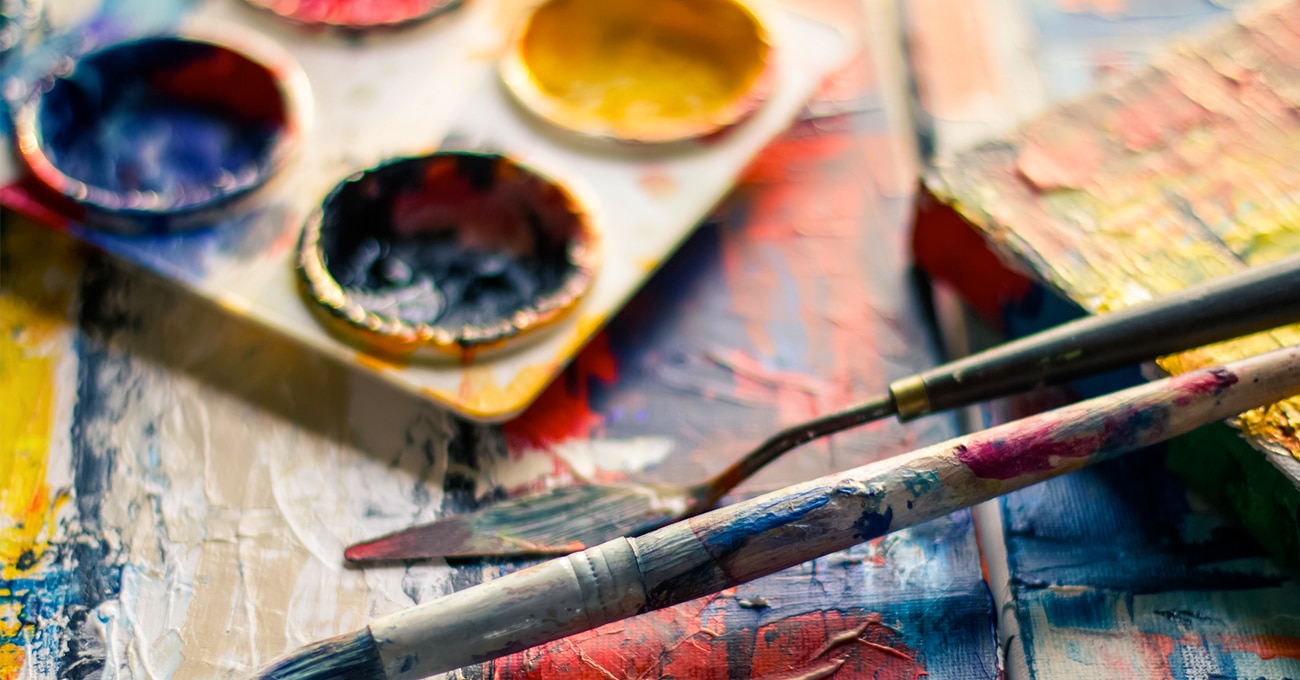ILL 333: Mixed Media Exploration
Explore creative art making methods and mediums
Time to get messy and have some art-making fun! In this course, you will explore, experiment, and expand your ability to conceptualize and develop compelling and innovative images through the use of technology, digital compositing, traditional drawing and/or painting techniques, mixed media, collage, and/or other art-making strategies. You will stretch your creative skills, discovering new avenues for your art and illustration, inspired by the concepts and strategies used by great artists past and present.

About This Course
Project-Based Learning
Students will engage in a series of creative mixed media projects, exploring the use of non-visual senses/sensibilities, compositional concepts, aesthetics, photo collage, abstraction, and source modification. Students will acquire an understanding of art-making methods in a historical context, learning new ways to think about composition.
What Skills Will I Develop?
Students in this course can expect to learn to:
- Explore and research a variety of creative image-making techniques such as employing technology, digital compositing, traditional drawing and/or painting techniques, mixed media, collage, and/or other artmaking strategies.
- Research and examine the work of recognized artists who employ mixed media strategies to produce their professional and artistic work.
- Experiment with multiple mixed media artmaking techniques in order to develop and produce visually compelling illustrations and creative artwork with consideration of historical concepts, artistic styles, aesthetics, and artmaking trends.
- Professionally present research and concepts in alignment with the course content, assignment criteria, and presentation guidelines.
- Actively participate in class discussions/meetings, constructively assess the work of your peers, and enhance your creative work based upon feedback.
- Demonstrate effective and efficient use of traditional media and classic techniques, consider proportion, perspective, value contrast, and the human figure (if applicable), and expand your ability to conceptualize and develop compelling and innovative illustrations and/or artwork.
- Where applicable, create images and graphics by effectively and efficiently using creative software including Adobe Photoshop, Illustrator, as well as other industry and web-based technologies.
- Produce and present your innovative image-making techniques and resulting creative work.
- Effectively generate, clearly convey, and support ideas by employing critical thinking, communication, and writing skills while considering divergent perspectives, cultural framing, historical context, research, and ethical concerns when providing critiques of peers’ work and participating in presentation sessions.
What Software and Supplies Do I Need?
- Computer with Internet connection.
- Art supplies: Most of the assignments allow for a choice of which medium you will want to use. I suggest looking through the individual projects first, before acquiring materials, and then decide which materials may serve you best. The following may be needed:
- Examples of Traditional Mediums: Color Pencils, Charcoal Pencils, Charcoal Sticks, Compressed Charcoal, Chalk Pastel, Oil Pastel, Watercolor, Gouache, Oil Paint, Acrylic Paint, India Ink, Ink Pens, Markers
- Examples of Traditional Grounds and Supports: Drawing Paper, Charcoal Paper, Pastel Paper, Watercolor Paper, Canvas, Canvas Board, Panel
- Experimental Mediums and Grounds: Do your research. Anything can be used to make art, but find out what goes together safely and successfully
- Other Necessary Supplies: Acrylic Matte Medium or Clear Craft Glue (Elmer’s Glue, X-Acto Blade or Scissors, Cutting Board, Kneaded Eraser, Pink Eraser, White Eraser
Course Instructor(s)
The course is taught by the following instructor(s):
 Jordon Schranz
Jordon Schranz
Jordon Schranz is an audio/visual artist and designer whose work has been exhibited internationally in New York, Chicago, El Paso, Berlin, Bogotá, and Ciudad Juárez.
Course Outline
What Is Mixed Media?
We'll define mixed media, distinguishing it from multimedia and exploring collage and appropriation as fundamental techniques
Early Examples of Mixed Media
In a wide-reaching survey of 20th and 21st century artists, we'll look at movements and major players in early mixed media, including Cubism, Surrealism, and Dada.
Expressive Mark Making
Moving from early mixed media to contemporary modes and movements, we'll explore Expressionism, Abstract Expressionism, Pop Art, and Postmodernism.
Frequently Asked Questions (FAQ)
How Do The Courses Work?
Our courses are project-based and instructor-led. In each course you’ll complete a series of lectures, projects, discussions, and critiques designed to stretch your creative skills. Weekly assignment deadlines keep you on track, so you can build your studies around your schedule. Two live Zoom meetings in this course provide the opportunity to work 1to1 with your instructor.
Who Are The Instructors?
Our courses are developed and taught by our industry-leading faculty of creative professionals. This means that you’ll learn in-demand skills, get feedback on your work, and build a portfolio of creative work. View our Student Gallery for featured student projects.
When Can I Start?
Classes start January, April, and August, and this course is completed in a 15-week term. This course is part of a Bachelor's Degree program at Sessions College. You can enroll in this course on an individual basis or as part of a program.
How Do I Register?
To register for a program, complete our program application. To register for this course on an individual basis, please contact our admissions team at admissions@sessions.edu. An Admissions Advisor will contact you to setup your enrollment.
| Course Tuition and Fees | |
|---|---|
| Tuition | $300/credit |
| Registration Fee* | $200 |
| Total Course Price | $1100 |
Registration fees are nonrefundable after 5 days from enrollment.
Is Sessions College Accredited?
Yes. Since 2001, Sessions College has been accredited by the Distance Education Accrediting Commission (DEAC). The Distance Education Accrediting Commission is listed by the U.S. Department of Education as a recognized accrediting agency and is recognized by the Council for Higher Education Accreditation (CHEA).





















